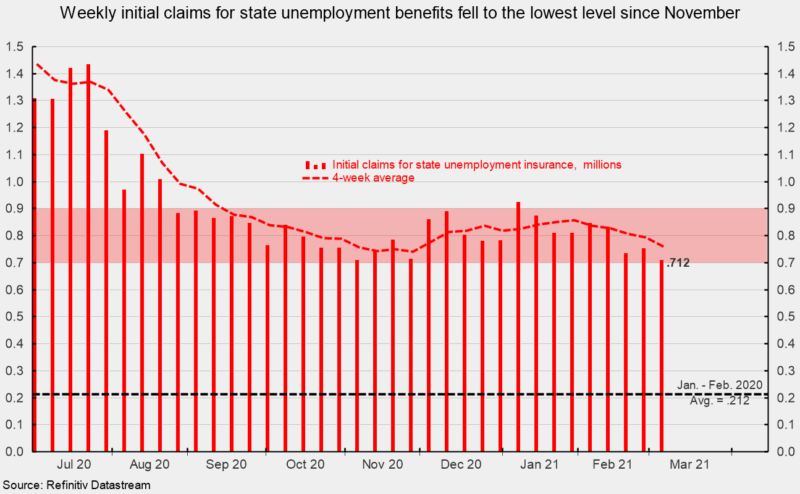– March 11, 2021
Initial claims for regular state unemployment insurance totaled 712,000 for the week ending March 6, down 42,000 from the previous week’s upwardly revised tally of 754,000 (see first chart). The latest week is the lowest since results for the week ending November 7, 2020. However, claims remain stuck in the 700,000 to 900,000 range and well above the pre-pandemic level of 212,000 in early 2020 (see first chart).
The four-week average fell 34,000 to 759,000, the fifth weekly decline in a row and the lowest level since November 28, 2020. However, the four-week average also remains stuck in the 700,000 to 900,000 range. The combination of vaccine distribution and easing government restrictions on consumers and businesses is likely to lead to lower claims in the coming weeks and months as the economy returns to normal operation. However, significant damage has been done by the lockdowns and full recovery is likely several quarters away.
The number of ongoing claims for state unemployment programs totaled 4.809 million for the week ending February 20, up 14,377 from the prior week and the first increase since the week ending January 2, 2021. State programs had been trending lower since early May, but the downward trend has turned to a flattish-to-slightly-lower trend since November with continuing claims holding in the 4 to 6 million range (see second chart). For the same week in 2019, ongoing claims were 2.101 million.
Continuing claims in all federal programs rose sharply in the latest week, coming in at 15.308 million for the week ending February 20 and the highest level since August 29, 2020 (see second chart). Since the beginning of June 2020, continuing claims in all Federal programs have been in the 12 to 16 million range, averaging 14.603 million.
The total number of people claiming benefits in all unemployment programs including all emergency programs was 20.116 million for the week ended February 20, up 2.087 million from the prior week and the highest level since December 5, 2020. Total claims have been in the 16 to 20 million range since November (see second chart).
Robert Hughes


Robert Hughes joined AIER in 2013 following more than 25 years in economic and financial markets research on Wall Street. Bob was formerly the head of Global Equity Strategy for Brown Brothers Harriman, where he developed equity investment strategy combining top-down macro analysis with bottom-up fundamentals.
Prior to BBH, Bob was a Senior Equity Strategist for State Street Global Markets, Senior Economic Strategist with Prudential Equity Group and Senior Economist and Financial Markets Analyst for Citicorp Investment Services. Bob has a MA in economics from Fordham University and a BS in business from Lehigh University.








The graph showing decline of state benefits simply means the states have depleted their funding. See this article…
https://www.investopedia.com/articles/personal-finance/080114/help-my-unemployment-benefits-are-running-out.asp
If the states were in good shape, then why the $1.9 trillion new federal relief program which will be distributed partially among the states.
The AIER data, although valuable, would be vastly improved with a comparison against real unemployment which according to the Fed Chair is closer to 10% rather than the 6% reported by the BLS.
https://www.nbcnews.com/business/economy/real-unemployment-rate-closer-10-percent-says-fed-chair-jerome-n1257331
Too many jobs and businesses will never return if/when COVID is under control. This is well known. Workers will have to reinvent themselves.
https://www.cnn.com/2020/07/07/economy/job-losses-coronavirus/index.html
McKinsey estimates 25% may have to change careers.
https://www.mckinsey.com/featured-insights/future-of-work/the-future-of-work-after-covid-19
The post-pandemic workplace will be evolving in front of us. Courage to those who are flexible.